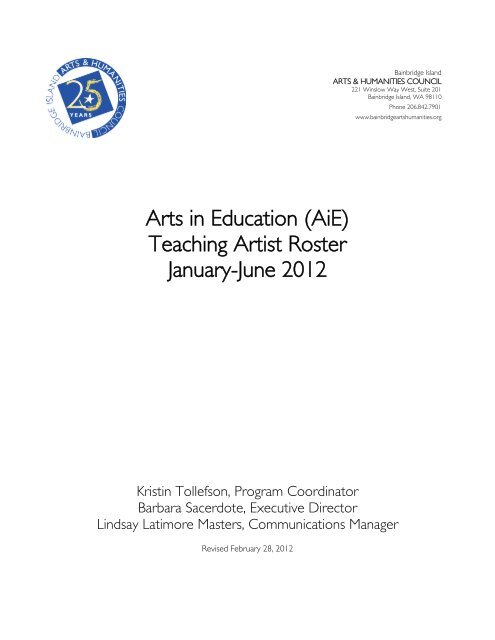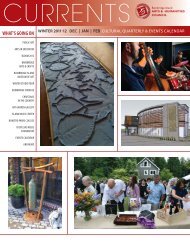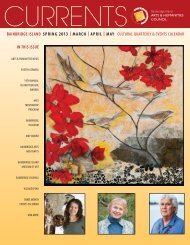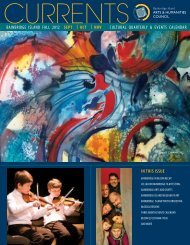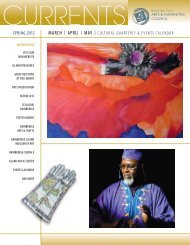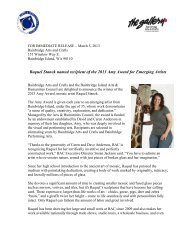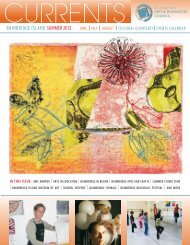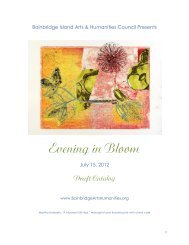Teaching Artist Roster - Bainbridge Island Arts & Humanities Council
Teaching Artist Roster - Bainbridge Island Arts & Humanities Council
Teaching Artist Roster - Bainbridge Island Arts & Humanities Council
You also want an ePaper? Increase the reach of your titles
YUMPU automatically turns print PDFs into web optimized ePapers that Google loves.
<strong>Arts</strong> in Education (AiE)<br />
<strong>Teaching</strong> <strong>Artist</strong> <strong>Roster</strong><br />
January-June 2012<br />
Kristin Tollefson, Program Coordinator<br />
Barbara Sacerdote, Executive Director<br />
Lindsay Latimore Masters, Communications Manager<br />
Revised February 28, 2012<br />
<strong>Bainbridge</strong> <strong>Island</strong><br />
ARTS & HUMANITIES COUNCIL<br />
221 Winslow Way West, Suite 201<br />
<strong>Bainbridge</strong> <strong>Island</strong>, WA 98110<br />
Phone 206.842.7901<br />
www.bainbridgeartshumanities.org
TABLE OF CONTENTS<br />
INTRODUCTION 3<br />
HOW TO USE THE TEACHING ARTIST ROSTER 4<br />
ARTISTS + ORGANIZATIONS<br />
DANCE<br />
<strong>Bainbridge</strong> Dance Center 5<br />
Sheila Phillips, Certified Dance Instructor 6<br />
INTEGRATED ARTS<br />
Pamela Dharamsey Lee 7<br />
Craig Jacob-Brown 8<br />
LANGUAGE ARTS<br />
Vicky Edmonds 9<br />
Nancy Rekow 10<br />
MEDIA ARTS<br />
Greg Stump 11<br />
Jack Straw Productions 12<br />
MUSIC<br />
Chenoa Egawa and Alex Turtle 13<br />
Nancy Houghton, MA, Music Therapist-Board Certified 14<br />
THEATRE ARTS<br />
Bonnie Showers 15<br />
Karen Harp-Reed 16<br />
Susan R. Anderson 17<br />
Tikka Sears 18<br />
VISUAL ARTS<br />
Kristin Tollefson 19<br />
Mesolini Glass 20<br />
Joe O’Brien 21<br />
Tim Lowell 22<br />
Melinda West 23<br />
Revised 2/28/12, 2:44 PM 2
INTRODUCTION<br />
We are delighted to introduce the <strong>Arts</strong> & <strong>Humanities</strong> <strong>Council</strong>’s 2012 <strong>Arts</strong> in Education program. Now<br />
in its 14th year, our award-winning <strong>Arts</strong> in Education program places professional teaching artists in<br />
classrooms for multi-day residencies. Each artist residency is tailored to the specific age and grade needs<br />
of your classroom in alignment with state learning standards. The pairing of high-level artists and<br />
classroom teachers provides powerful arts programming for your student.<br />
For a quarter century, the <strong>Arts</strong> & <strong>Humanities</strong> <strong>Council</strong> has nurtured <strong>Bainbridge</strong> <strong>Island</strong>'s cultural community<br />
with programs, services, and collaborations that form the core of our mission: to create an environment<br />
on <strong>Bainbridge</strong> <strong>Island</strong> in which the arts and humanities flourish. <strong>Arts</strong> in Education is the most vital aspect<br />
of this commitment to our community; last year we engaged 2,200 young people in a full range of quality<br />
arts and humanities programs.<br />
The <strong>Arts</strong> & <strong>Humanities</strong> <strong>Council</strong>’s <strong>Arts</strong> in Education program is a partnership with the <strong>Bainbridge</strong> <strong>Island</strong><br />
School District, BISD PTOs, principals, classroom teachers, teaching artists, and families. It is funded by<br />
the <strong>Arts</strong> & <strong>Humanities</strong> <strong>Council</strong> through our fundraising such as our Annual Appeal as well as by our<br />
garden tour <strong>Bainbridge</strong> in Bloom. We have also been awarded grants from the Washington State <strong>Arts</strong><br />
Commission, the <strong>Bainbridge</strong> Community Foundation, and the Suquamish Tribe to support this dynamic<br />
program.<br />
If you have any questions regarding the <strong>Arts</strong> in Education program, please feel free to contact Kristin<br />
Tollefson, Program Coordinator, at kristint@bainbridgearthumanities.org. Kristin is a nationally renowned<br />
artist, arts educator, and <strong>Bainbridge</strong> <strong>Island</strong> School District parent, and we're thrilled to have her filling this<br />
role.<br />
Barbara Sacerdote, Executive Director<br />
<strong>Bainbridge</strong> <strong>Island</strong> <strong>Arts</strong> & <strong>Humanities</strong> <strong>Council</strong><br />
Revised 2/28/12, 2:44 PM 3
HOW TO PLAN A RESIDENCY<br />
1. Use the <strong>Teaching</strong> <strong>Artist</strong> <strong>Roster</strong> to find a teaching artist for your school<br />
• When scheduling residencies with the <strong>Arts</strong> in Education (AiE) program, you may work with artists who<br />
appear on the <strong>Teaching</strong> <strong>Artist</strong> <strong>Roster</strong>. These artists have been prequalified with an eye to rigorous best practices<br />
standards and are knowledgeable about the Washington State Essential <strong>Arts</strong> Learning Requirements (EALRs).<br />
• Additional information is available from Kristin Tollefson, Program Coordinator for <strong>Arts</strong> in Education.<br />
•Ask yourself:<br />
• What do you want your students to learn from this residency?<br />
• What will you learn from this residency?<br />
• What curricular elements or Essential Learnings will the residency connect with in your classroom?<br />
• How will the residency impact teaching and learning in the classroom after it concludes?<br />
2. Contact <strong>Teaching</strong> <strong>Artist</strong>(s)<br />
• Schools may make initial contact directly with <strong>Teaching</strong> <strong>Artist</strong>s to inquire about availability or suitability for<br />
work in their classroom.<br />
• Be clear about your goals, class needs and concerns. <strong>Teaching</strong> <strong>Artist</strong>s are eager to work with Classroom<br />
Teachers to tailor their teaching to best suit the specific environment.<br />
3. Contact AiE Program Coordinator<br />
• Schools must work with the <strong>Arts</strong> in Education Program Coordinator to hire their artist, following the AiE<br />
policy. <strong>Teaching</strong> <strong>Artist</strong>s are not guaranteed payment unless they are contracted directly through the <strong>Arts</strong> &<br />
<strong>Humanities</strong> <strong>Council</strong>, even if your school has been received funding approval.<br />
4. Plan and Implement your Residency<br />
• Classroom teachers are expected to complete the Planning Form with the <strong>Teaching</strong> <strong>Artist</strong> to create a wellintegrated<br />
residency that supports classroom curriculum; participate in residency activities in the classroom at all<br />
times with their students; and assess both student learning and the overall impact and quality of the residency.<br />
• <strong>Teaching</strong> <strong>Artist</strong>s’ planning and preparation time with the Classroom Teacher is a required component of this<br />
program. Allocate one (1) hour preliminary planning time and orientation for the <strong>Teaching</strong> <strong>Artist</strong> with all<br />
participating Classroom Teachers. Familiarize <strong>Teaching</strong> <strong>Artist</strong>s with the space and materials that will be<br />
available. Ask them to provide pre- or post-residency guides or lesson plans for teachers to use with students.<br />
4. Communicate<br />
• Let the <strong>Teaching</strong> <strong>Artist</strong> know if lessons are meeting your planned goals, or conversely, if you observe lessons<br />
that are working particularly well.<br />
• Contact the Program Coordinator with comments, questions or concerns at any point during the planning or<br />
residency process. The success of the program depends on everyone remaining informed!<br />
Thank you for participating in the <strong>Bainbridge</strong> <strong>Arts</strong> & <strong>Humanities</strong> <strong>Council</strong>’s <strong>Arts</strong> in Education program!<br />
Revised 2/28/12, 2:44 PM 4
ARTISTS + ORGANIZATIONS<br />
DANCE<br />
Susan Thompson, <strong>Artist</strong>ic Director & President<br />
Gary Reed, Education Outreach Coordinator<br />
<strong>Bainbridge</strong> Dance Center<br />
844 Madison Avenue North<br />
<strong>Bainbridge</strong> <strong>Island</strong>, WA 98110<br />
206-842-1497<br />
dancingsusan@yahoo.com<br />
Harpreed@w-link.net<br />
Area of Study: Dance Instruction & Appreciation<br />
Possible Curricular Ties: Math, Physical Education<br />
Grade(s): K-7<br />
Teacher Resources: Lesson Plans/Resources will be provided to the teachers at least one week in<br />
advance of the scheduled project.<br />
Sample Residency Topics<br />
Dance Appreciation in the Classroom<br />
Two Dance Class Study at the <strong>Bainbridge</strong> Dance Center Studio<br />
Brain Dance and Beyond<br />
Sample Residency Description<br />
Dance and Math Classroom Visits<br />
Two visits by a dance/movement specialist to your classroom to explore the connections between<br />
dance concepts and math concepts. Each session will start with exploring BrainDance patterns that<br />
integrate the pre-selected math concepts the students are studying. Creative movement activities will<br />
help students with different learning styles deepen their understanding of the math concepts. Teachers<br />
select concepts from shape recognition, patterns, symmetry/asymmetry, flips and slides, math facts,<br />
counting, place value, fractions, and geometry. (EALRs 1.1, 1.2, 2.1, 4.2)<br />
Susan Thompson, dancer, choreographer, and director of <strong>Bainbridge</strong> Dance Center, graduated with<br />
honors from Mt. Holyoke College with a B.A in English and Dance. Trained in ballet and modern with<br />
emphasis on Cunningham technique, she has performed professionally in Boston, New York and New<br />
Mexico. She is on the faculty of West Sound Academy, and has been with the BI <strong>Arts</strong> Consortium since<br />
its conception.<br />
Gary Reed is a dancer, choreographer, and movement specialist, who began his dance career with<br />
musical theatre in Northern California. He graduated from the University of Utah with a B.A. in<br />
modern dance and has been dancing and teaching in the Northwest for 24 years. He has been at the<br />
<strong>Bainbridge</strong> Dance Center for 10 years. As director of their outreach program, he brings extensive<br />
dance education to public and private schools on the <strong>Island</strong>. Gary has been working with the<br />
<strong>Bainbridge</strong> <strong>Island</strong> <strong>Arts</strong> Consortium, moving with students and teachers, since it began.<br />
Revised 2/28/12, 2:44 PM 5
DANCE<br />
Sheila Phillips, Certified Dance Instructor<br />
Educated Feet<br />
707 Village Circle NW<br />
<strong>Bainbridge</strong> <strong>Island</strong>, WA 98110<br />
206-842-3012<br />
sheila@educatedfeet.net<br />
Area of Study: Dance Instruction<br />
Possible Curricular Ties: history, social studies, band & math<br />
Grade(s): 5-12<br />
Teacher Resources: Lesson plans provided<br />
Sample Residency Description<br />
Ballroom, Latin and Swing<br />
Learn how to execute dance patterns with a partner in Ballroom, Latin and Swing dances. Choose<br />
from various Swing, Foxtrot, Waltz, Slow dance and Hustle. Latin styles include Salsa, Tango,<br />
Rumba, Cha Cha and Merengue. Dance etiquette is included. Dancing boosts morale and provides<br />
fun exercise in Physical Education. History curriculums can be supplemented with Swing dance from<br />
the WWII era and Latin America’s dance influences from Argentina and Cuba. Certainly, dance<br />
compliments band and music electives!<br />
Focus: The student understands and applies arts knowledge and skills by understanding arts concepts<br />
and vocabulary (EALR 1.1), developing arts skills and techniques (EALR 1.2) and understanding and<br />
applying arts styles from various artists, cultures and times (EALR 1.3). The student communicates<br />
through the arts by using the arts to express and present ideas and feelings (EALR 3.1). The student<br />
makes connections within and across the arts to other disciplines, life and cultures by demonstrating<br />
and analyzing the connections among art disciplines (EALR 4.1) and understanding that the arts shape<br />
and reflect culture and history (EALR 4.4)<br />
Sheila Phillips, a <strong>Bainbridge</strong> <strong>Island</strong> resident, is a certified instructor in Ballroom, Latin and Swing<br />
dance. Sheila was co-founder and coach of the nationally award winning <strong>Bainbridge</strong> <strong>Island</strong> teenage<br />
dance troop, the Swingin’ Hepcats. Sheila believes in sharing the joy of dance with another and finds<br />
special satisfaction in teaching social partner dancing. She loves working with teens and presently<br />
teaches classes through <strong>Bainbridge</strong> Metro Park and Recreation and island health clubs.<br />
Revised 2/28/12, 2:44 PM 6
INTEGRATED ARTS<br />
Pamela Dharamsey Lee<br />
Ox + Dragon<br />
12089 Miller Road<br />
<strong>Bainbridge</strong> <strong>Island</strong>, WA 98110<br />
206-855-8225<br />
oxdragon@msn.com<br />
Area of Study: Integrated <strong>Arts</strong> (dance, music & performance)<br />
Possible Curricular Ties: language arts, history, science, physical education<br />
Grade(s): K - 8<br />
Teacher Resources: Lesson plans will be provided at least two weeks in advance of scheduled project.<br />
Sample Residency Topics<br />
Fleas: A Guided performance process<br />
Paved With Gold: immigration through family histories, theatrical improvisation and song<br />
Sample Residency Description<br />
Earth From Above<br />
Based on the work of Yann Arthus Bertrand and Andrea Goodman, students will be introduced to<br />
environmental concepts through drawing, photography, drama, movement, music and improvisation.<br />
Through a "Bird's Eye View" they will look at the Earth From Above and work on group<br />
collaborations to express their thoughts kinesthetically.<br />
Pamela Dharamsey Lee of Ox + Dragon has been teaching integrated arts workshops for public<br />
school children since 1990. She has been an artist-in-residence for The Children’s Museum of<br />
Manhattan and the Touchstone Center for children. Her work in West Puget Sound has included<br />
creating cultural performing arts events at the <strong>Island</strong> School, Theatre Education at BPA, teaching<br />
dance and choreography at <strong>Bainbridge</strong> Ballet, and most recently West Sound Academy.<br />
Revised 2/28/12, 2:44 PM 7
INTEGRATED ARTS<br />
Craig Jacob-Brown<br />
The Maskery<br />
Indianola, WA<br />
360-297-4160<br />
Jacobrown@themaskery.com<br />
Area of Study: Mask-making, Sculpture & Performing <strong>Arts</strong><br />
Grade(s): 3-7<br />
Teacher Resources: Lesson Plans provided<br />
Sample Residency Topics<br />
Northwest Native Masks and Dance<br />
Endangered Species Masks and Dance<br />
Balinese Shadow Puppetry<br />
Mask Dance/Puppet Theatre Traditions<br />
Wild and Disciplined Monkeys of the Ramayana<br />
Sample Residency Description<br />
Personal Connections—Northwest Cultural Traditions and Environment<br />
Objectives:<br />
1. Students will observe Northwest Native American sculptural, storytelling and dance styles in order<br />
to demonstrate their understanding of these forms.<br />
2. Students will be able to choose northwest animal symbols with personal significance to them to<br />
work collaboratively in small groups construct and perform stories that express origins values and<br />
characteristics important to them.<br />
<strong>Arts</strong> EALRs:<br />
1.3 Understands and applies arts styles from various artists, cultures and times.<br />
2.1 Develops creative art work independently with some teacher assistance<br />
4.3 Demonstrates the impact art has on personal, community and natural environment<br />
4.4 Demonstrates how the arts shape and reflect culture.<br />
Craig Jacobrown, sculptor, mask maker, performer, educator, has been performing puppetry and mask<br />
theater ever since he was in high school. He began teaching mask, carriage, and theater soon after he<br />
graduated from school. His biggest inspiration has been his world travels where he has sought out<br />
mask and puppet teachers to train him in their unique styles. He also sculpts on commission, teaches<br />
many grades and subjects, and tours a one man mask/puppet show called 'World Mask Theater'.<br />
Revised 2/28/12, 2:44 PM 8
LANGUAGE ARTS<br />
Vicky Edmonds<br />
4742 42nd Ave SW #307<br />
Seattle, WA 98116<br />
206-937-0700<br />
Vickyedmonds@ealloftheabove.com<br />
Area of Study: Poetry<br />
Grade(s): K -12<br />
Teacher Resources: Lesson plans follow<br />
Sample Residency Description<br />
Writes of Passage --Introductory Poetry Classes in teaching meaning<br />
A series of workshops on using the art and practice of writing as an opportunity for bringing our truest<br />
voice to the page and to the world. This class includes an introduction to writing poetry, why we write<br />
things, how it helps, how we keep our best ideas, bring them as food and medicine to the world; an<br />
introduction to imagery and using details to describe invisible feelings inside; a discussion about<br />
"Invisible Beauties" ©, the amazing things that come tucked inside of human beings but that we can't<br />
see - our hopes, dreams, wishes, kindness, our spirit, truth, thoughts, feelings, strengths... etc. This<br />
residency is an opportunity to try to prove to more children their undeniable beauty through their own<br />
words.<br />
Vicky Edmonds is a passionate writer and teacher of poetry in the Seattle area, and has taught around<br />
the country and abroad over the last 15 years. She has worked in hundreds of elementary, middle, high<br />
schools, universities, arts, humanities and youth organizations, women’s and parenting groups. Her<br />
published books include Inside Voices, used to the dark, the first two volumes in the Writes of Passage<br />
series. Her articles have appeared in anthologies published nationally. Vicky has also compiled and<br />
published over 180 books of the poetry of the children and at-risk youth she has taught.<br />
Revised 2/28/12, 2:44 PM 9
LANGUAGE ARTS<br />
Nancy Rekow<br />
Journeys with Words<br />
PO Box 4568<br />
Seattle, WA 98061<br />
206-842-4855<br />
nancyrekow@msn.com<br />
Area of Study: Poetry, Writing<br />
Grade(s): 1-12<br />
Teacher Resources: Classes designed to enhance teacher’s curriculum. Lesson plans provided.<br />
Sample Residency Topics<br />
Painting with Poems: Have a Ball & Practice Basic Writing Skills<br />
Poetry Sampler: Haiku, Mistranslations & Other Forms<br />
Sample Residency Description<br />
To Write Fine Poems: Creativity & Craft<br />
Writing a poem is a journey of discovery. Students write poems freely, without the constriction of<br />
rhyme, thereby unleashing their creativity. Poems offer immense freedom of subject matter and form.<br />
Students write from their own experiences, insights, & imaginings. They listen to & appreciate each<br />
other’s poems. They learn to appreciate poetry as an art form. Along the way, they practice specific<br />
skills, learning to use: images (the 5 senses), specific details, simile/metaphor, rhythm, repetition,<br />
alliteration, reading aloud, listening, & revising. These basic skills are of course taught by all<br />
teachers, but when students write poems (short & easy to focus on) they can learn to apply these skills<br />
whenever they write, whatever they write -- be it poems, stories, essays, etc. They learn to trust the<br />
“journey” of writing. They learn that writing is an art they can enjoy, experiment with, and polish.<br />
They learn to respect & appreciate writing as an art form Nancy will assist with displays, readings, or<br />
publication of students’ poems if desired. Questions/ideas always welcome.<br />
Nancy Rekow has taught in various public schools & community colleges. She is a Poet-in-the-<br />
Schools, widely published and award-winning poet; private tutor & teacher of writing for all ages, and<br />
publishing consultant and freelance editor. Many of her students have published and won awards,<br />
including recognition from the Washington Poets Association. She has assisted with student<br />
publications, displays, and readings. In recent years she has arranged displays and readings for<br />
National Poetry Month (April) sponsored by <strong>Bainbridge</strong> <strong>Island</strong> <strong>Arts</strong> & <strong>Humanities</strong> <strong>Council</strong> at BPA &<br />
<strong>Bainbridge</strong> Public Library.<br />
Revised 2/28/12, 2:44 PM 10
MEDIA ARTS<br />
Greg Stump<br />
915 E. Harrison St. #307<br />
Seattle, WA 98102<br />
206-568-5059<br />
gstump7@yahoo.com<br />
Area of Study: Cartooning & Animation<br />
Possible Curricular Ties: Language <strong>Arts</strong>, History, Social Studies, Science<br />
Grade(s): 2-8<br />
Sample Residency Topics<br />
Create a Class Comic Book<br />
Using Comics to Engage and Illuminate<br />
Sample Residency Description<br />
Simple Animation: Flip Books and Zoetrope Strips<br />
Cartoonist Greg Stump will demonstrate and assist students in the creation of manual animated<br />
cartoons, first by presenting some visual strategies for their creation, and then by showing examples of<br />
successful approaches to making flip book sequences and zoetrope strips. Each student will work on<br />
his or her own flip book to take home, in addition to creating simple paper strips which, when shown<br />
in a zoetrope spool, create an animated effect. Focus: Developing art skills and techniques (EALR 1.2);<br />
understanding arts concepts and vocabulary (EALR 1.1); and using the arts to express and present<br />
ideas and feelings (EALR 3.1)<br />
Greg Stump has been a cartoonist and teacher in Seattle for a decade. His comics and illustrations<br />
have appeared in the The Stranger newsweekly since 2000, and his comic book series Urban Hipster<br />
has been nominated for multiple industry awards. Greg is also a longtime and regular contributor to<br />
The Comics Journal, published by Fantagraphics Books. He has worked with Coyote Central, <strong>Arts</strong><br />
Corps, Powerful Schools, Seattle University, the Kirkland <strong>Arts</strong> Center, Gage Academy, the Bellevue<br />
Art Museum, the Frye Art Museum, and many others.<br />
Revised 2/28/12, 2:44 PM 11
MEDIA ARTS<br />
Joan Rabinowitz<br />
Jack Straw Productions<br />
4261 Roosevelt Way NE<br />
Seattle, WA 98105-6999<br />
206-634-0919<br />
joan@jackstraw.org<br />
Area of Study: Sound Art, Radio Stories, Oral Histories<br />
Possible Curricular Ties: Science (Physics), Social Studies, History, Language <strong>Arts</strong><br />
Grade(s): 3-7<br />
Teacher Resources: Lesson Plans provided<br />
Sample Residency Topics<br />
Radio Narratives<br />
Sample Residency Description<br />
Physics of Sound: Science to Art, Landscape and Soundscape<br />
Students will learn about the basic concepts of sound (e.g. sound waves, frequency, pitch), while<br />
looking at projections of actual waveforms and experimenting with creating sounds from almost<br />
anything. Students and artists will create and record improvised soundscapes.<br />
Instructors: Sound <strong>Artist</strong> Susie Kozawa, Engineer CJ Lazenby<br />
Grade(s): This workshop is ideal for 3rd grade physics of sound curriculum unit and is also adaptable<br />
for grades 4 through 7.<br />
Jack Straw Productions has a commitment to art and technology education for all ages. Through our<br />
radio drama, music, and creative audio production programs, students work with professional artists<br />
to learn about the arts and to develop ways to express themselves creatively. Students produce final<br />
projects in the form of radio shows, sound collages, professional music and/or spoken voice<br />
recordings, historical audio documentation, oral history recordings and more!<br />
Revised 2/28/12, 2:44 PM 12
MUSIC<br />
Chenoa Egawa and Alex Turtle<br />
PO Box 1415<br />
Kingston, WA 98346<br />
360-297-9530<br />
chenoaegawa@hotmail.com<br />
Area of Study: Music, Native Drumming & Storytelling<br />
Possible Curricular Ties: Social Studies, Music, Language <strong>Arts</strong><br />
Grade(s): 4-8<br />
Sample Residency Description<br />
Native American Drum Workshops<br />
Chenoa and Alex will work together and offer 2 one-hour classes. In the first class, they will bring a<br />
variety of hand drums and a water drum. In an interactive setting, they will share teachings about each<br />
of the drums, their significance and importance, and how, when and why they are used. They will talk<br />
about the materials used to make drums and demonstrate a couple of ways that drums can be tied.<br />
They will also share several different songs and their meanings with the students. For the second class<br />
they will bring materials for each student to make their own little drum (approximately 3”- 4”<br />
diameter). By the end of the second session students will have gained a wealth of information about<br />
the drums and be left with a greater understanding and respect for their significance and value to<br />
Native cultures and to all people.<br />
Chenoa Egawa is Lummi and S’Klallam. She is a singer and composer of traditional Native American<br />
songs. She has recorded five CD’s. She also hosts Northwest Indian News, a television news program<br />
highlighting stories, issues and events of Native peoples of Washington State, Alaska and Vancouver<br />
B.C. She has worked in Indian education for 16 years.<br />
Alex Turtle is Navajo and Southern Cheyenne. He was born and raised on the Navajo reservation.<br />
Navajo is his first language. He had the great blessing of being raised by his grandparents, and was<br />
taught to carry forth the wisdom, knowledge, teachings and ceremonial ways of his elders. He is a<br />
singer, drummer and composer of traditional Native songs and has recorded two CD’s thus far. He<br />
has been sharing Native songs, stories and drumming with children throughout North Kitsap Schools,<br />
<strong>Bainbridge</strong> <strong>Island</strong> Schools, the Lummi Nation School, and in schools across the Navajo Nation for<br />
many years.<br />
Revised 2/28/12, 2:44 PM 13
MUSIC<br />
Nancy Houghton, MA, Music Therapist-Board Certified<br />
PO Bo 4508<br />
Rolling Bay, WA 98061<br />
(206) 371-5312<br />
nhhoughton@msn.com<br />
Possible Curricular Ties: Language <strong>Arts</strong>, Social Studies, Health & Physical Education<br />
Grade(s): K-8<br />
Teacher Resources: Lesson Plans will be provided to the teacher at least one week prior to the activity.<br />
Sample Residency Description<br />
Learning Through Music<br />
Nancy Houghton is a board certified music therapist. She is offering a series of music-based activities<br />
designed to address non-musical goals. Depending on the classroom teacher’s needs, music sessions<br />
may address cognitive, emotional or physical goals. Nancy creates a session using a variety of<br />
interventions such as drumming, rhythm instruments, movement, singing, and the Brain Dance.<br />
Possible areas of focus may be: increasing attention to task, taking turns, teamwork, enhancing<br />
creativity, exploring movement concepts such as spatial awareness, fine and gross motor skills, speech.<br />
<strong>Teaching</strong> occurs in a fun, non-threatening environment in which students develop improved<br />
confidence and self-awareness. Instruments will be provided by Nancy Houghton. No additional<br />
materials are required. Appropriate for special needs or typical classrooms.<br />
Nancy Hurlow Houghton is a Board Certified Music Therapist as recognized by the American Music<br />
Therapy Association and the Certification Board for Music Therapists. She holds a Bachelor of Music<br />
in Music Therapy from the University of the Pacific in Stockton, CA, and a Masters of <strong>Arts</strong> in Music<br />
Therapy from Saint Mary-of-the Woods College in Indiana. Nancy has pursued additional training in<br />
Guided Music and Imagery, the uses of Cross-Cultural Music and Sound in Healing, Healthy Rhythms,<br />
and The Rhythmic <strong>Arts</strong> Project. She conducts private practice with adults and children on <strong>Bainbridge</strong><br />
<strong>Island</strong> and serves as adjunct faculty teaching music therapy at Seattle Pacific University.<br />
Revised 2/28/12, 2:44 PM 14
THEATER ARTS<br />
Bonnie Showers<br />
8051 NE Paulanna Lane<br />
<strong>Bainbridge</strong> <strong>Island</strong>, WA 98110<br />
206-855-7816<br />
BonnieShowers@msn.com<br />
Area of Study: Play Production, Classical Dance & Theatre of Japan, China, India & Bali<br />
Possible Curricular Ties: literature/language arts, history, world cultures<br />
Grade(s): 3 - 7<br />
Teacher Resources: Lesson Plans in development<br />
Sample Residency Topics<br />
Classroom Community Play Production<br />
Beijing Opera: The classical theatre of China<br />
Classical dance/theatre from India<br />
Dance & culture of Bali<br />
Sample Residency Description<br />
Classical Theatre in Japan<br />
This class focuses on an introduction to one or more of the classical theatre forms of Japan: Noh<br />
(stately masked theatre), Bunraku (3 man puppet tradition), Kabuki (colorful large movement and<br />
make-up) (Can be narrowed to one form, depending on teacher's needs). Includes experience of<br />
movement and voice, discussion of classical Japanese aesthetics--what is considered beautiful.<br />
Includes experience of music, voice, costume elements, and social classes/character types represented<br />
in the classical theatre. (Warriors, merchants, women, farmers). Student experiences can include<br />
learning a simple Noh chant, trying the 3-person puppet operating technique, and trying Kabuki<br />
character movement. Focus is on understanding concepts and vocabulary (EL1.1), applying responding<br />
process in the arts (EL2.3) and making connections within and across arts, life, cultures, work. (EL4.1-<br />
4.5). Room requirements: Cleared Space to move, Tape/CD player; VCR and Monitor<br />
Bonnie Showers holds an MFA in Asian Performance and Directing from the University of Hawaii. A<br />
professional theatre director for over 20 years, Bonnie has taught acting, directing, voice and<br />
movement, and Asian theatre studies at both nationally and abroad in Germany, Italy, and Austria.<br />
She was <strong>Artist</strong>ic Director of two German companies focused on developing ensemble multidisciplinary<br />
works: Theaterwerk San Francisco Berlin, and Theater im Pumpenhaus, Muenster.<br />
Bonnie also enjoys consulting work on <strong>Arts</strong> Ed Consortia building for several communities across<br />
Washington State.<br />
Revised 2/28/12, 2:44 PM 15
THEATER ARTS<br />
Karen Harp-Reed<br />
Raggamuffen Enterprises<br />
4102 41st Ave S.<br />
Seattle, WA 98118<br />
206-723-8311<br />
harpreed@w-link.net<br />
Area of Study: Theatre and Creative Movement<br />
Possible Curricular Ties: Language <strong>Arts</strong>, Math, Physical Education<br />
Grade(s): K-8<br />
Teacher Resources: Lesson plans and Discography list and materials on the Brain Dance (developed<br />
by Anne Gilbert) provided.<br />
Sample Residency Topics<br />
Creative Movement and Theatre<br />
Creative Movement and Theatre Performance<br />
Theatre in the Classroom<br />
Theatre in the Classroom Performance<br />
Sample Residency Description<br />
Folk tales, Poetry, Stories for young readers; take a story, any story, and learn to bring it to life.<br />
Through the elements of dance and theatre using the body and mind, literature comes alive for early<br />
readers. Every lesson incorporates social skills and empathy training as well as individual expression.<br />
Learning about space: self and general and moving through space with their bodies, students can also<br />
learn the concepts of rhythm in language and sequencing of words and story. All projects will be<br />
designed individually with the teacher and artist’s input. EALR Focus: 1.1 understands arts concepts<br />
and vocabulary, 1.1.2 understands Principles of Organization, 1.2 develops arts skills and<br />
techniques,1.4 applies audience skills in a variety of settings, 2.1 applies a creative process in the arts.<br />
Karen Harp-Reed has taught and performed for the last 30 years as a multi-artist in Washington and<br />
California. She has extensive experience teaching singing, theatre, and creative dance movement, as<br />
well as communication and facilitation skills with students from preschool to adult. She has been a<br />
music/dance/theatre specialist from pre-K to 8th grade as a credentialed teacher, a Master Teacher at<br />
universities and teacher workshops, a music director for professional productions, and director for<br />
community theatre programs. She also is a professional singer and actor who has performed locally<br />
at the 5th Ave. Theatre, Issaquah Village Theater, Civic Light Opera, and Crepe de Paris.<br />
Revised 2/28/12, 2:44 PM 16
THEATER ARTS<br />
Susan R. Anderson<br />
1181 Irene Place NE<br />
<strong>Bainbridge</strong> <strong>Island</strong>, WA 98110<br />
206-842-6838<br />
draminedu@gmail.com<br />
Area of Study: Theatre <strong>Arts</strong>, Music, Drama in Education<br />
Possible Curricular Ties: History, Science, Language <strong>Arts</strong>, Math<br />
Grade(s): 2- 8<br />
Sample Residency Topics<br />
From Book to Play<br />
Stories Alive!<br />
Small Scripts: Staged Readings<br />
Sample Residency Description<br />
Songs of History<br />
From a “Toast to George Washington” written in 1781, Woody Guthrie’s “Roll on<br />
Columbia” written in 1936 and <strong>Bainbridge</strong> <strong>Island</strong>er, Ron Konzak’s “The Gooey Duck Song”<br />
and a telling of the Pig War call “San Juan Pig”, songs reflect and tell the stories of history.<br />
The American Revolution, the Civil War, the 100 years between the two, the Depression<br />
and the Wild West, even the Alaska-Yukon Exposition, all had songs written to celebrate an event or<br />
express a deep feeling. Integrate songs of the period of history into the Social Studies unit you are<br />
studying. The teaching artist will bring her keyboard and teach the class the music and the words of the<br />
songs of the classroom teacher’s choice. The teaching artist will then help small groups act out the<br />
songs, bring action and meaning to the words. Discussion will end the session to assess what<br />
was learned.<br />
EALR Focus: 1.2 develops arts skills and techniques; 1.2 understand a applies arts styles from various<br />
artists, cultures and times; 3. 1 uses arts to express and present ideas and feelings; 4.1 demonstrates and<br />
analyzes the connections among the arts disciplines; 4.2 demonstrates and analyzes the connections<br />
between the arts and other content areas; 4.4 understands that the arts shape and reflect culture and<br />
History.<br />
Susan Anderson has been creating dramas in classrooms on <strong>Bainbridge</strong> <strong>Island</strong> for 18 years. She is one<br />
of the original artists with the Consortium. Her work allows students to experience aspects of<br />
curriculum in imaginative ways and brings out hidden skills in students.<br />
Revised 2/28/12, 2:44 PM 17
THEATRE ARTS<br />
Tikka Sears<br />
c/o SE Asia Center UW<br />
115 Prefontaine Place South #501<br />
Seattle, WA 98104<br />
206-484-6796<br />
tikka_s@yahoo.com<br />
Area of Study: Drama, Mask Dance & Puppet Theatres of South and Southeast Asia<br />
Possible Curricular Ties: Social Studies, Language <strong>Arts</strong><br />
Grade(s): K-8<br />
Classroom Requirements: Cleared space to move, Tape/CD Player, VCR and Monitor<br />
Sample Residency Topics<br />
Art and Dance: the dramatic horse dance of Java Indonesia<br />
Indonesian Mask Dance and Puppet Theater Performance (School Assembly)<br />
Introduction to Ramayana and Mahabharata Oral Epic Traditions<br />
Oral History in Performance from the Local to the Global<br />
Sample Residency Description<br />
The Monkey Kings, Ogres, Queens and Princes of the Asian Stage<br />
Physical Theater and Character Study Using the masks and character types of Southern Asia.<br />
Performing artist Tikka Sears will lead students through the dance and movements of 5 major character<br />
types of the Ramayana epic. Students will explore movement, masks, character and vocal qualities of<br />
each of the principal characters. Focus is on experiential learning of oral transmission, dramatic forms,<br />
storytelling, vocabularies and concepts. The final session will conclude with a performance<br />
collaboration between the students and the artist. The artist will include a mask dance performance and<br />
lecture demo with video footage of the character types in one of the sessions. EALRs implemented:<br />
1.1, 1.2, 1.3, 1.4, 2.3, 3.2. and 4.1-4.5.<br />
Tikka Sears, Theater Director, Actor, Dancer and Choreographer has studied traditional and<br />
contemporary performing arts of Indonesia, Javanese mask dance, theater and puppetry since she was<br />
7 years old. She lived in Indonesia for over 5 years and between 2002-2004 had a Fulbright <strong>Artist</strong><br />
Grant to study with contemporary Indonesian theater artists. In addition to performing and directing,<br />
Sears has been artist-in-residence at Franklin High School and director and coach for student projects<br />
at the University of Washington. There, Sears is Outreach Coordinator for the Southeast Asia Center,<br />
where she presents and organizes workshops, lectures and resources for K-12 educators.<br />
Revised 2/28/12, 2:44 PM 18
VISUAL ARTS<br />
Kristin Tollefson<br />
4515 Eagle Harbor Drive NE<br />
<strong>Bainbridge</strong> <strong>Island</strong>, WA 98110<br />
klt@raincity.com<br />
206.842.0253<br />
Area of Study: Sculpture, nature journals (drawing, watercolor & writing), site-specific installations<br />
Possible Curricular Ties: social studies (technology, manufacturing, human systems); math (pattern,<br />
proportional limits [Fibonacci sequence, Pi and the Golden Ratio]; science (ecology, botany, animal<br />
architecture).<br />
Grade(s): K-12<br />
Teacher resources: Lesson plans and bibliography provided.<br />
Sample Residency Topics<br />
Look Again: Drawing and the Nature Journal<br />
Sculptural Pods: The Wire Garden<br />
Mobiles: Balance, Movement and Color<br />
Art in Nature: Environmental Sculpture<br />
Sample Residency Description<br />
Sculptural Pods: The Wire Garden<br />
Using industrial wire and other materials, students will learn textile techniques applied to metal as they<br />
create botanically inspired sculptural forms. This residency will begin with a survey of botany in<br />
world artistic traditions (EALRs 1.1-1.3) and a discussion of representation, abstraction and the<br />
correlation between science and art (EALRs 3.4-3.5, 3.7). Students will gain hands-on knowledge of<br />
pattern and repetition through handwork, each building a stylized sculptural botanical specimen. The<br />
workshop culminates with desktop display and discussion followed by an exhibit of student projects in<br />
the classroom, school display case, or library (EALR 2.1).<br />
Kristin Tollefson’s work includes sculpture, installation, performance and jewelry. She holds an MFA<br />
in Metalsmithing from Cranbrook Academy of Art and a BA, Cum Laude, in Art History and<br />
Anthropology/Sociology from Carleton College. She has taught at schools including Cornish College<br />
of the <strong>Arts</strong>, Vista Academy, Pratt Fine <strong>Arts</strong> Center, The Children’s Museum of Seattle, and Centrum,<br />
and has received grants and awards from such organizations as Fulbright, The American-<br />
Scandinavian Foundation, <strong>Bainbridge</strong> <strong>Island</strong> <strong>Arts</strong> & <strong>Humanities</strong> <strong>Council</strong>, <strong>Artist</strong> Trust, and Jack Straw.<br />
Her permanent public sculptures can be seen throughout the Puget Sound region.<br />
Revised 2/28/12, 2:44 PM 19
VISUAL ARTS<br />
Diane Bonciolini<br />
Mesolini Glass Studio<br />
13291 Madison Ave NE<br />
<strong>Bainbridge</strong> <strong>Island</strong>, WA 98110<br />
206-842-7133<br />
Mesoliniglass@earthlink.net<br />
Area of Study: Fused Glass<br />
Possible Curricular Ties: Science, Math, History<br />
Grade(s): K-7<br />
Teacher Resources: Lesson plans available<br />
Sample Residency Topics<br />
Self-Portrait Study in Fused Glass<br />
Sample Residency Description<br />
Glass <strong>Artist</strong> in the Classroom: Fused Glass Mini-projects<br />
Diane Bonciolini also comes into the classroom for smaller fused glass projects, either a fused-glass<br />
pendant or mini-frame. During these sessions the students will collage small brightly colored glass<br />
shards creating their specific designs. The student’s work is then taken to the artist’s studio for firing.<br />
The artist then returns to the classroom and facilitates student reflections on the project, reasons for<br />
their choices of design, color and shape, and their responses to the process and completed work.<br />
Students will learn and apply concepts while learning new vocabulary (EALR 1). Students will apply<br />
their own art styles using the creative process (EALR 2) of collage while making a connection (EALR<br />
4) with glass and an artist of this discipline.<br />
Diane Bonciolini and her husband Greg Mesmer are Mesolini Glass Studio. During the past 10 years<br />
they have worked in various <strong>Artist</strong>s In Residence programs in King and Kitsap Counties, bringing<br />
glass fusing into the schools. They have worked with children as young 3 years through middle school.<br />
Their work has been featured in public commissions throughout Washington State, including the<br />
Community Quilt on <strong>Bainbridge</strong> <strong>Island</strong> at Madison Avenue and Winslow Way.<br />
Revised 2/28/12, 2:44 PM 20
VISUAL ARTS<br />
Joe O’Brien<br />
O’Brien Clay Works<br />
206-842-6448<br />
fanuja@aol.com<br />
Area of Study: Hand Built Clay<br />
Possible curricular ties: Language <strong>Arts</strong>/Reading, Social Studies, Science<br />
Grade(s): K-7<br />
Sample Residency Topics<br />
Where the Wild Things are in Clay<br />
The Jabberwocky Comes to Life<br />
Clay artist and teacher collaboration in the classroom<br />
Sample Residency Description<br />
Clay Caricature Birds<br />
Joe O’Brien will introduce the students to various clay hand building techniques such as creating pinch<br />
pots, coil making to create original and whimsical creatures. Various texturing techniques such as<br />
stippling, combing and applied designs will also be used in the projects. These projects can be<br />
associated with language arts and science.<br />
The first session will consist of students creating their creatures.<br />
The second session will have the students adding detail and painting their fired creations.<br />
Cost: $200<br />
Size: one class<br />
Grade level: K-7<br />
Joe O’Brien, potter, received his BA from the University of Washington and MA and MFA from<br />
Northern Illinois University. Joe has spent the last years teaching on <strong>Bainbridge</strong> <strong>Island</strong> and in<br />
Suquamish, and has been self-employed in the pottery business for over 40 years. Elida, Joe’s wife,<br />
teaches pottery classes for the parks district at the Eagledale Pottery. Together, they have<br />
participated in many shows in the Northwest including the Bellevue Art Fair, Art in the Pearl in<br />
Portland, OR, and the <strong>Bainbridge</strong> <strong>Island</strong> Studio Tour.<br />
Revised 2/28/12, 2:44 PM 21
VISUAL ARTS<br />
Tim Lowell<br />
Tim Lowell Artworks<br />
5317 Welfare Ave.<br />
<strong>Bainbridge</strong> <strong>Island</strong>, WA 98110<br />
206-780-0422<br />
Tim@ActiveArtandScience.com<br />
www.ActiveArtandScience.com<br />
Area of Study: Mosaic Sculpture & Tile, Art & Chemistry<br />
Possible Curricular Ties: Science, Math, History<br />
Grade Level: K-12<br />
Sample Residency Topics<br />
Art & Science Integration: Creating art with chemistry<br />
Sample Residency Descriptions<br />
Create a Mosaic Tile<br />
<strong>Artist</strong>/Sculptor Tim Lowell will visit your classroom with a dazzling, colorful array of safe, tumbled<br />
stained glass pieces. Each student will design, create and take home a functional glass mosaic tile.<br />
Students will jump right into creating their artwork expressing their imagination and creativity through<br />
the use of color and the tactile medium. Option: Teachers can pick a subject and let students create<br />
their own mosaic version of it.<br />
Focus on: Developing art skills and techniques (EALR 1.2). Understanding and applying art styles<br />
from various cultures and times (EALR 1.3). Using the arts to express and present ideas and feelings<br />
(EALR 3.1)<br />
Tim Lowell, <strong>Bainbridge</strong> <strong>Island</strong> sculptor, has been creating, exhibiting, selling and teaching about<br />
mosaic art for the last seven years. He has worked with many students to create mosaic art projects<br />
large and small at numerous Kitsap County schools, libraries, park programs and others. Tim is the<br />
proud father of two creative children.<br />
Revised 2/28/12, 2:44 PM 22
VISUAL ARTS<br />
Melinda West<br />
West Gardens Basketry<br />
PO Box 323<br />
Indianola, WA 98342<br />
360-297-2809<br />
melwest@centurytel.net<br />
Area of Study: Basketry & Weaving, Northwest Native Fiber, Bird Nests<br />
Possible Curricular Ties: Math, Science, Social Studies, History<br />
Grade(s): K - 8<br />
Classroom requirements: There is an additional materials fee of $6 to $14 per student.<br />
Sample Residency Topics<br />
Birds and their Nests<br />
Finding Rhythms In Nature – Weaving Cattail Rattles<br />
Weaving Salmon – Exploring the Salmon Life-Cycle<br />
The Cedar Experience – Weaving With the Western Red Cedar<br />
Sample Residency Description<br />
Northwest Fiber<br />
Natural fiber weaving helps students connect to the natural environment. It’s fun for young learners to<br />
learn ancient universal fiber technologies, and to make something beautiful from the humblest of plant<br />
materials. This experience can help your students gain an appreciation of the traditional ecological<br />
knowledge held by First Peoples cultures from around the world, and right here in the Puget Sound<br />
Region. As they practice this traditional art form, your students have an opportunity to investigate<br />
their own indigenous roots, and to celebrate the cultural and biological wealth of our Earth. Each of<br />
the following art experiences includes a preparatory meeting between teacher and artist where you can<br />
choose the lesson focus, and we can collaborate on ways to broaden the connections between subjects<br />
and make the experience relevant for your students. The lesson emphasis can enhance understanding of<br />
concepts related to the following EALRs: Pacific Northwest history and culture. (4.1, 4.2, 4.3, 4.4,<br />
4.5); Northwest Forest, wetland, open space and shoreline ecosystems. Watersheds and the hydrologic<br />
cycle. (4.2, 4.3, 4.4, 4.5); Ethnobotany and relationships between people, plants and wildlife. Cycles<br />
of plant growth and change over time and seasons. Plant material gathering and curing processes.( 1.1,<br />
1.1.2, 1.2, 3.2, 4.2); Designing and planning a project using a variety of plant materials or recycled<br />
materials. (2.1, 3.2, 3.3); Recognizing visual and auditory patterns in nature. Physics of sound. (2.1,<br />
4.1, 4.2)<br />
Melinda West of Indianola, Washington, has practiced the art of natural fiber weaving for over twentyfive<br />
years. She has studied with many native and non-native weavers and artists, the foremost being<br />
Ed Carriere of the Suquamish Tribe. Her primary inspiration comes from nature and the First<br />
Peoples of the Pacific Northwest. Melinda enjoys sharing her love of natural history, environmental<br />
stewardship, and indigenous cultural and environmental knowledge. Along with her work as an artist,<br />
she has taught at the Seattle Art Museum, <strong>Island</strong>Wood, North Cascades Institute, Olympic Park<br />
Institute, as well as in public and private schools throughout the Northwest.<br />
Revised 2/28/12, 2:44 PM 23


